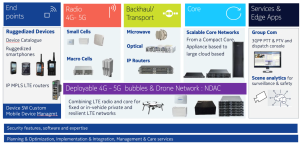Perspective
Building critical networks for the digital era

Emergencies and calamities can happen at any time. When disaster strikes, every second counts. Detecting events in real time, sharing of information and effective monitoring of each situation is essential for protecting lives. However, public safety agencies often lack access to latest technologies to optimally manage such situations. Public safety a.k.a. Public Protection and Disaster Relief (PPDR) has been a slow mover when it comes to the adoption of new age technologies as compared to other segments. However, there has been a growing realization for the need for digitization to bring in more intelligence and scalability to the underlying communication networks to achieve the best outcome while using fewer human resources.
Public Protection and Disaster Relief (PPDR) agencies worldwide are gearing up for a major digital transformation of their communication networks by embracing new age technologies, for improving their operational effectiveness in conducting relief and rescue missions.
Traditional narrowband technology solutions, used by PPDR agencies, such as TETRA, P25 etc mostly offer voice and basic data services, and fall short of enabling the digitalization in true sense. Also, the communication networks used by different PPDR agencies often work in silos and are not interoperable. This also hampers the sharing of information across various PPDR agencies in a seamless manner.
Consequently 4G/ LTE, a 3GPP standardized technology, has emerged as a key enabler for driving digital transformation; and enhancing first responders’ situational awareness and operational capabilities. By virtue of its easy scalability, better coverage, QoS assurance and secure communication, it addresses majority of the mission critical requirements – be it the traffic capacity, latency, security, interoperability, or ecosystem- while offering opportunities for innovation to develop new capabilities for improving overall execution of the operations. Furthermore, it also offers a future evolution path to 5G. PPDR agencies in US, UK, Germany, Korea, Japan, UAE etc, are using 4G/ LTE to support a wide range of of use cases for public safety.
5G will widen the scope of PPDR
5G, has lot more to offer vis-à-vis the previous technologies, especially in emergency situations, when quick decision making and speedy transfer of large volumes of data can help save lives and every second matters. Now is the time for PPDR agencies to start planning as to when and how to adopt it and take advantage of its capabilities.
5G can widen the scope of public safety manifold owing to its high speed, low latency, enhanced security, and massive connectivity capabilities – be it predictive medical care and monitoring, integration of artificial intelligence (AI) or use of augmented reality (AR) or be it enhanced situational awareness for ensuring road safety for drivers and pedestrians. For instance:
- Real time video services: 5G will allow the use of higher resolution cameras than before and increase the number of cameras in specific hotspots where capacity is currently limited by 4G
- Connected and automated vehicles/drones: Automated or remotely controlled vehicles or drones can be used to provide better situational awareness, or logistics delivery in hostile environments. In addition, 5G allows vehicles to connect to road infrastructure so that drivers can be alerted at crossroads – for example, to avoid collisions
- eHealth: High guaranteed 5G uplink speeds can empower moving ambulances to transmit life-critical data to hospitals, including high-definition video and the outputs of sophisticated medical tools along with real-time video communication
- Immersive applications for first responders: 5G will ensure consistent and timely data transmission for augmented-reality (AR) applications such as face recognition in a crowd or visualizing the team members’ positions in real time during operations
- Connected devices: Agencies can make broader use of environmental sensors (including noise, smoke, traffic, etc.), biometric devices and body cameras particularly in emergencies with a high concentration of first responders.
- Traffic prioritization: 5G allows to efficiently prioritize network traffic for mission-critical applications and provide prioritized access to first responders in case of emergencies.
- Security: 5G offers enhanced security against cyber threats over the previous generation of technologies. 5G solution adapts to address changes in attacks and detects threats as early as possible for faster responses.
How Nokia can help
The adoption of 5G for PPDR will be incremental, starting with complementing 4G and later evolving as the mainstream technology for PPDR services. Nokia is working closely with The Critical Communications Association (TCCA) and 3GPP for the development and standardization of mission-critical communication solutions. Our engagement with the public safety community and a 60-year long history of working with government customers such as security agencies gives us a deep understanding of mission-critical networks and their needs.
More than 190 organizations across the globe have relied on Nokia for IP, optical, microwave and radio technology, for building their purpose designed critical networks. Some of the notable engagements being:
- Ministry of Public Safety and Security (MPSS), Korea for building a dedicated and nationwide broadband wireless service network
- Ministry of Interior, Qatar for building Middles East’s first public safety LTE network
- Emergency Services Network, UK for building world’s first FDD -LTE public safety emergency services over commercial network
- FirstNet USA, America’s First Nationwide Public Safety Broadband Network for building a nationwide seamless, IP-based, high-speed mobile communications network based on LTE Band.

Visit our website https://www.nokia.com/networks/industries/public-safety/ to discover how Nokia’s mission-critical systems are enabling transformation in public safety communications networks.















You must be logged in to post a comment Login